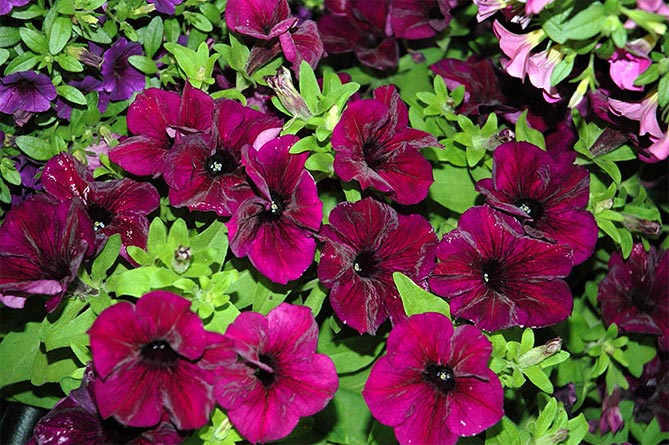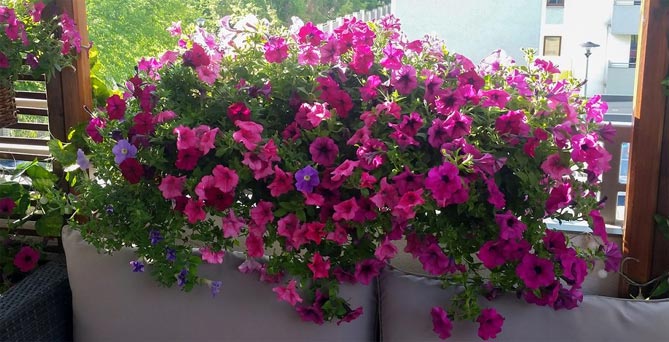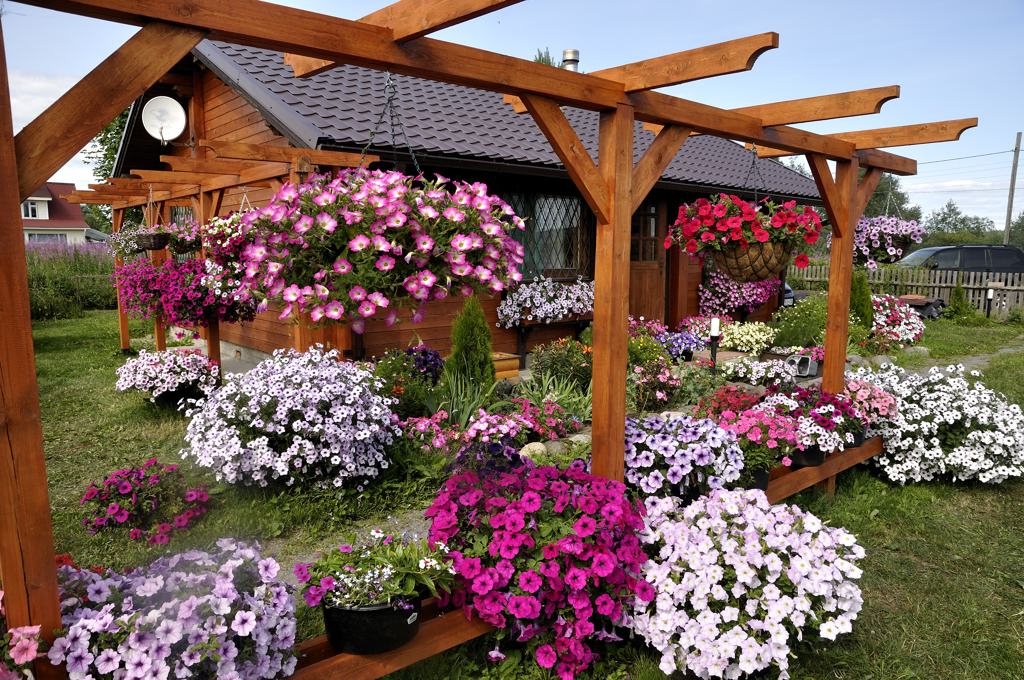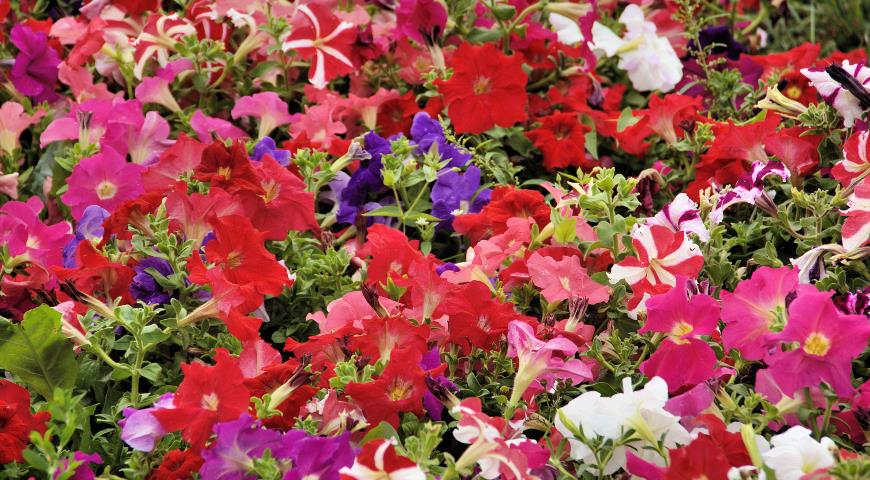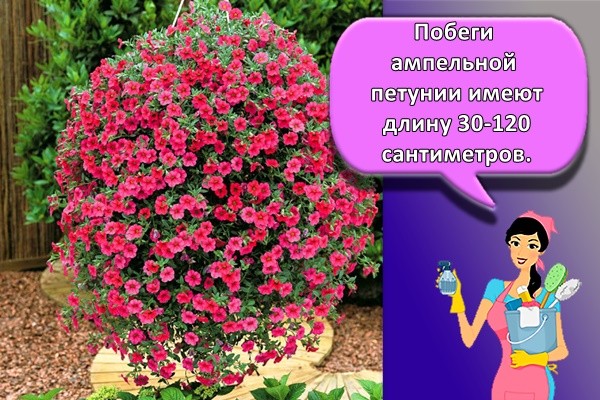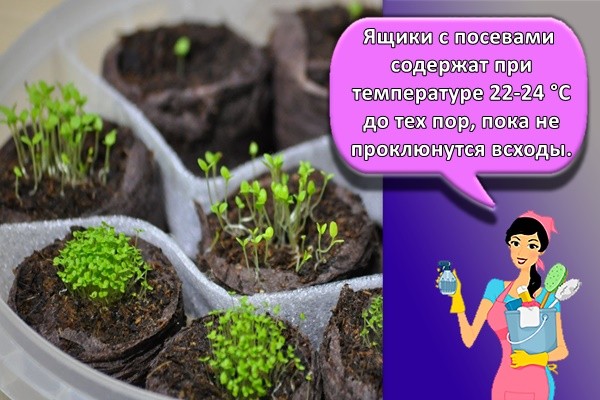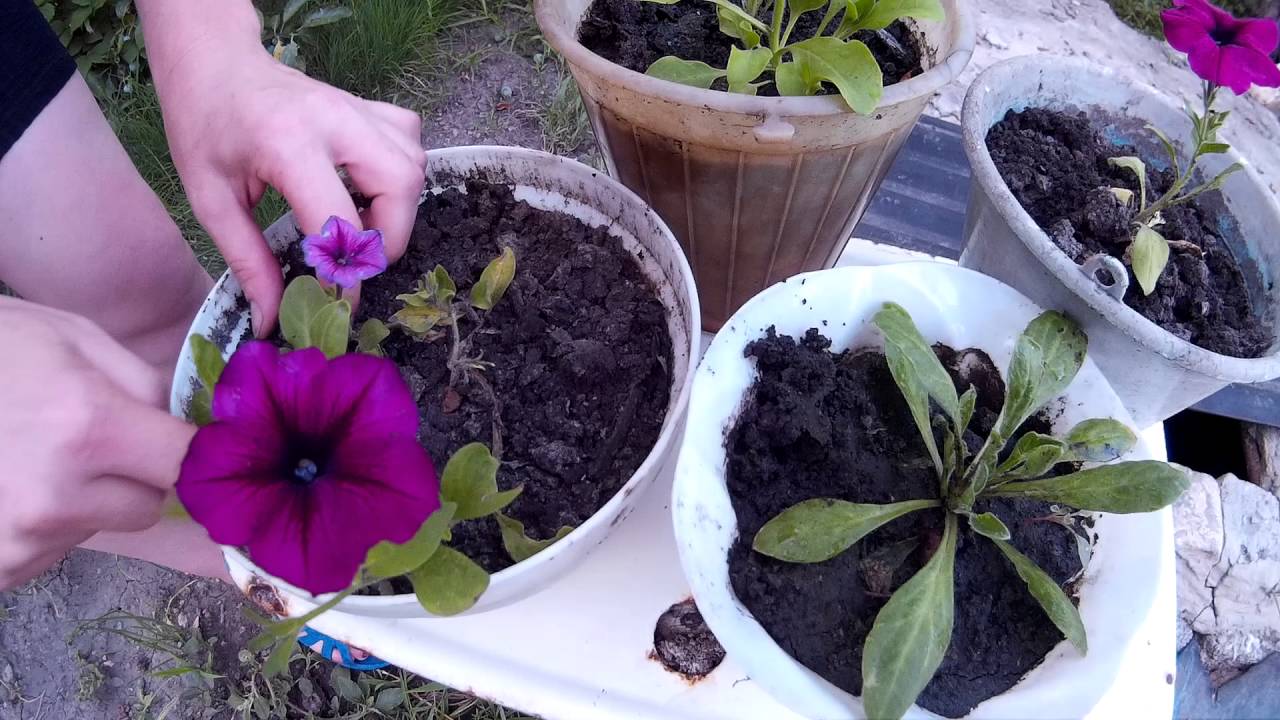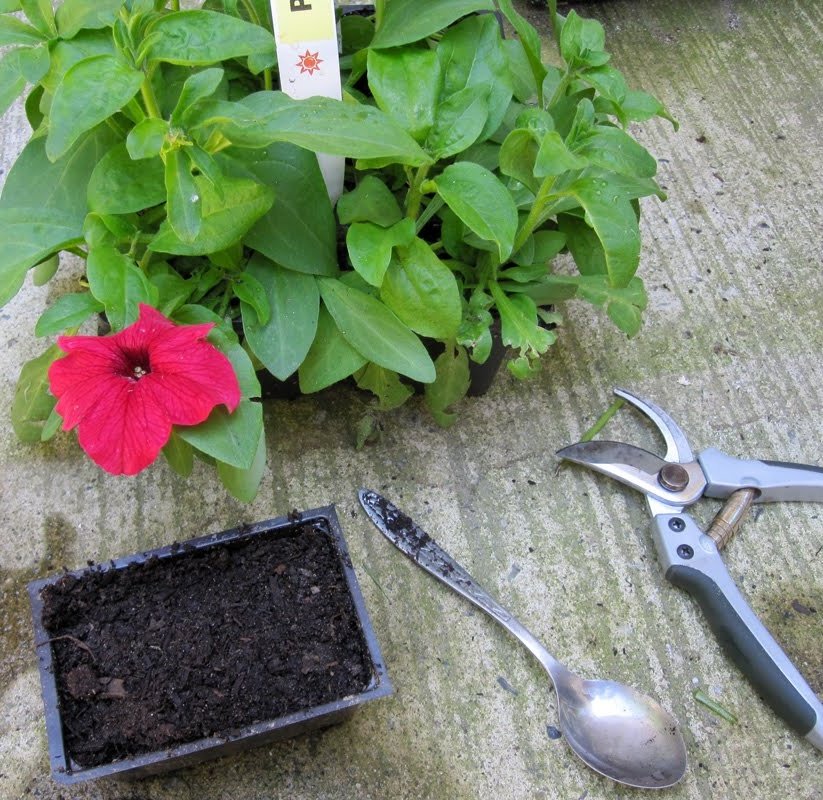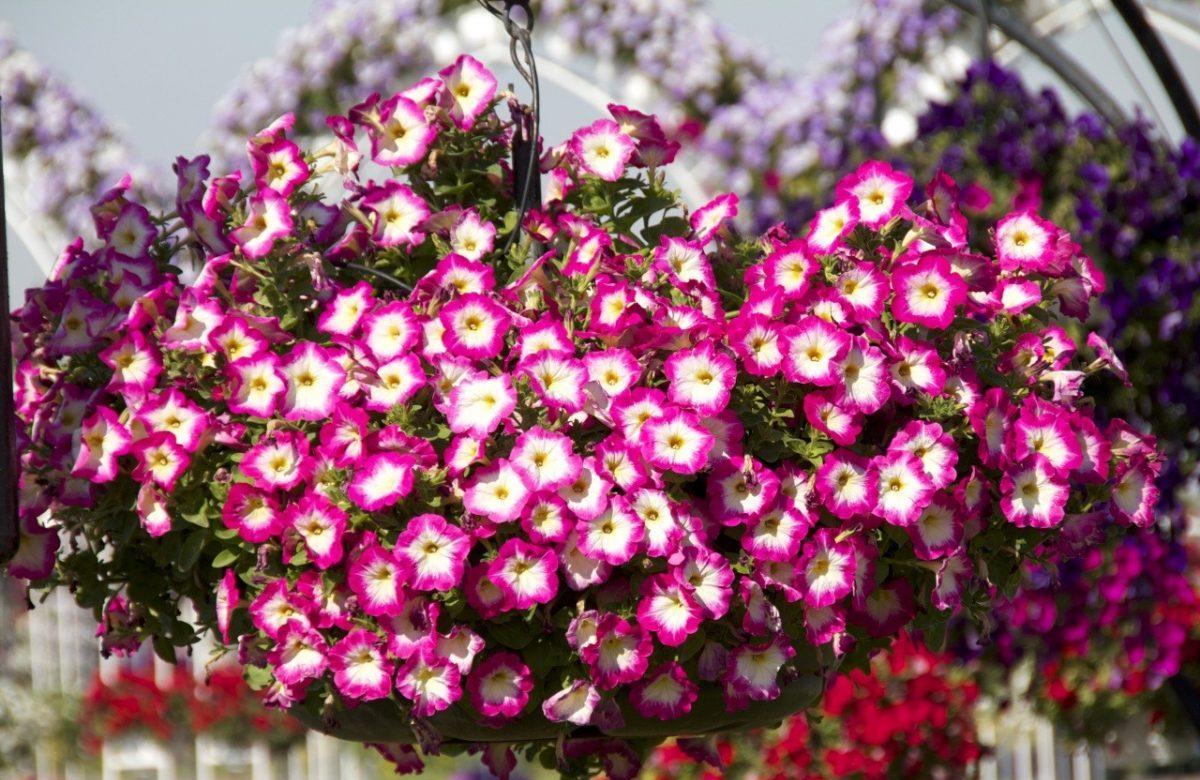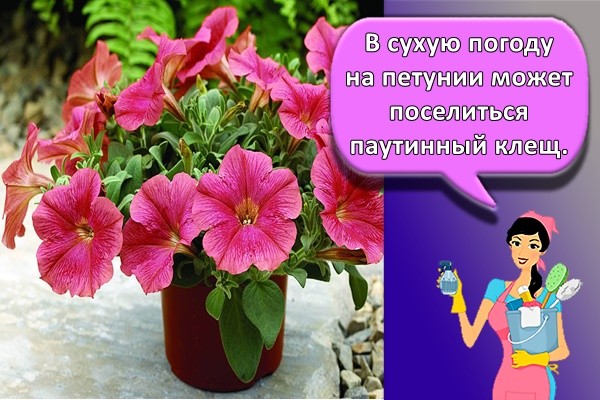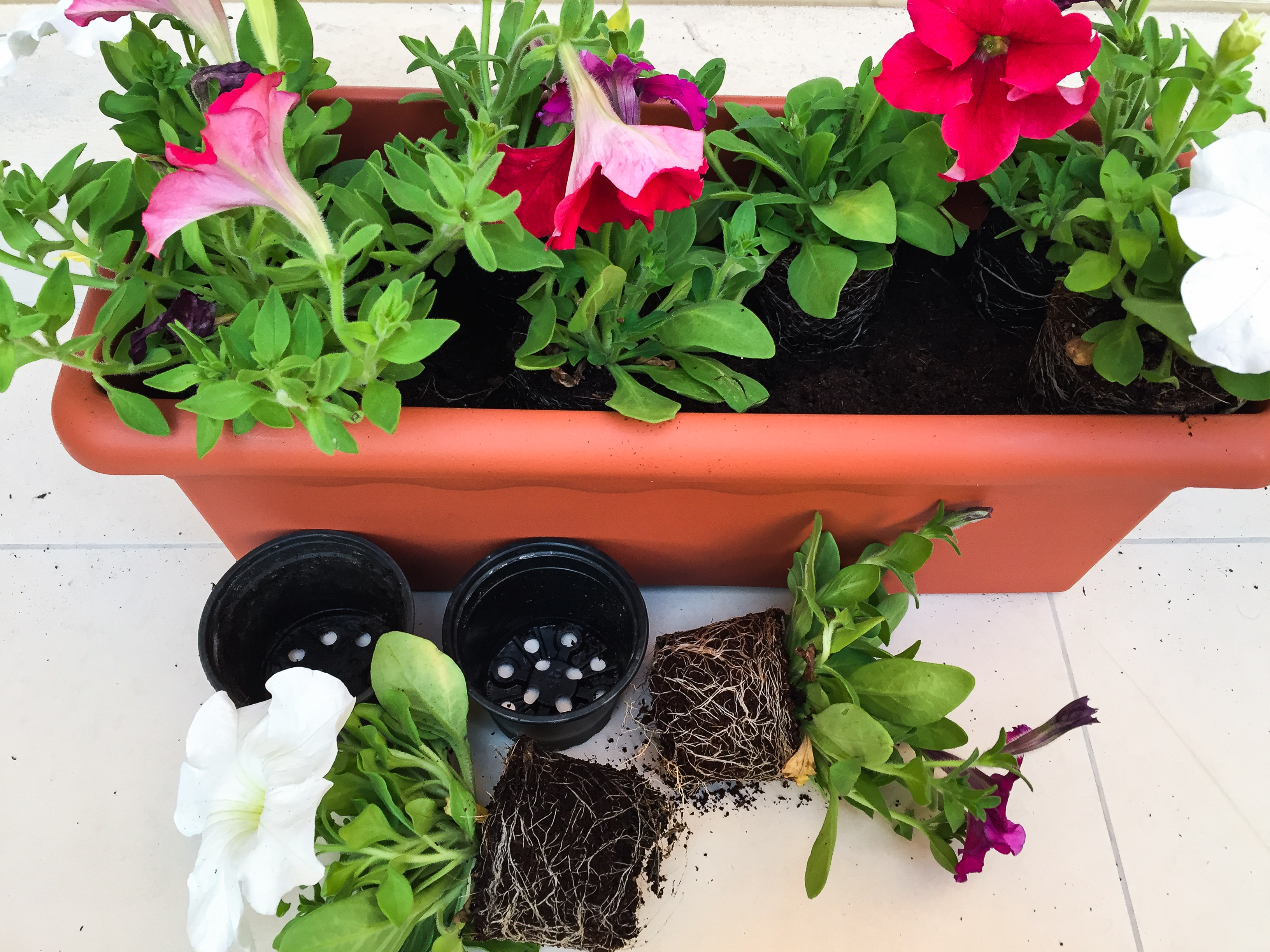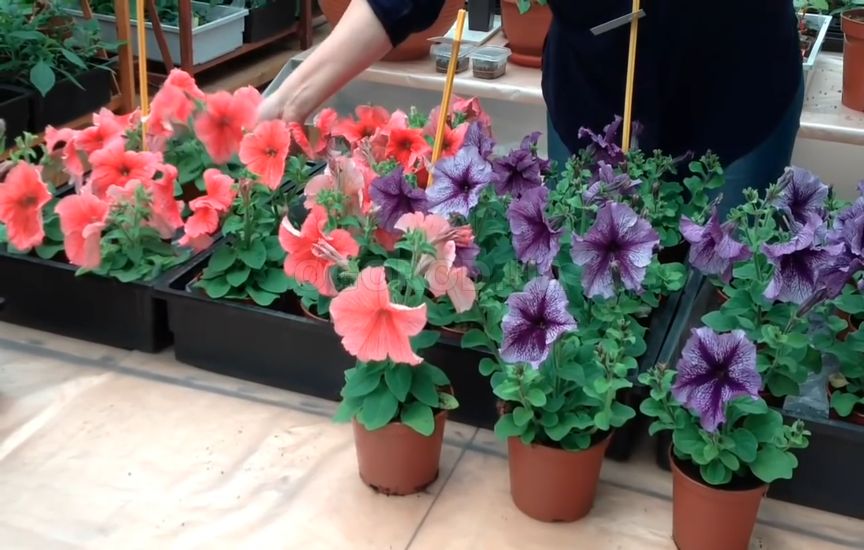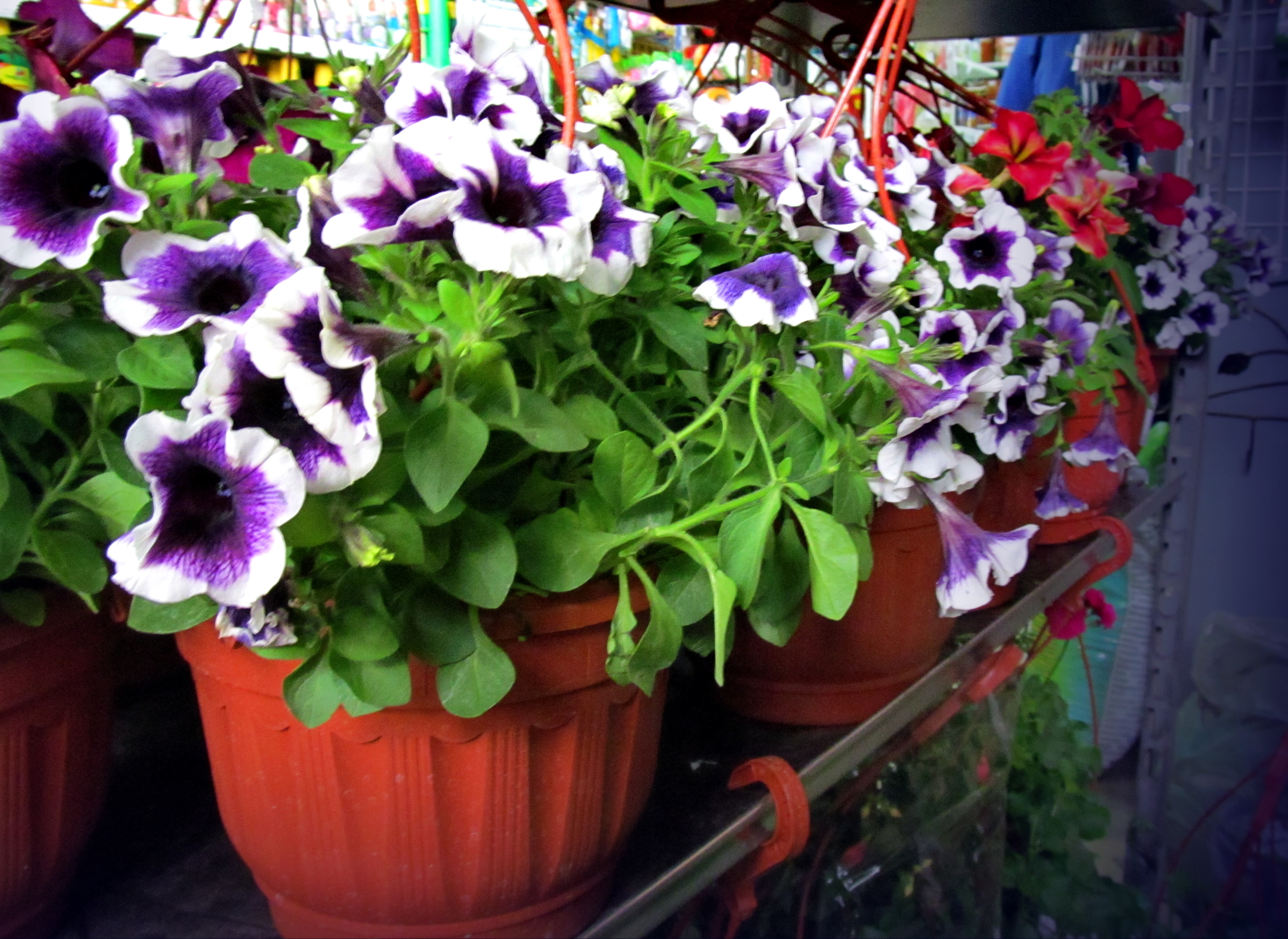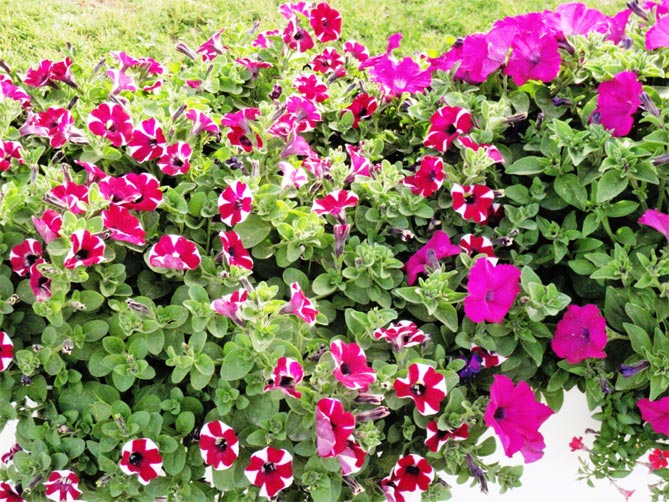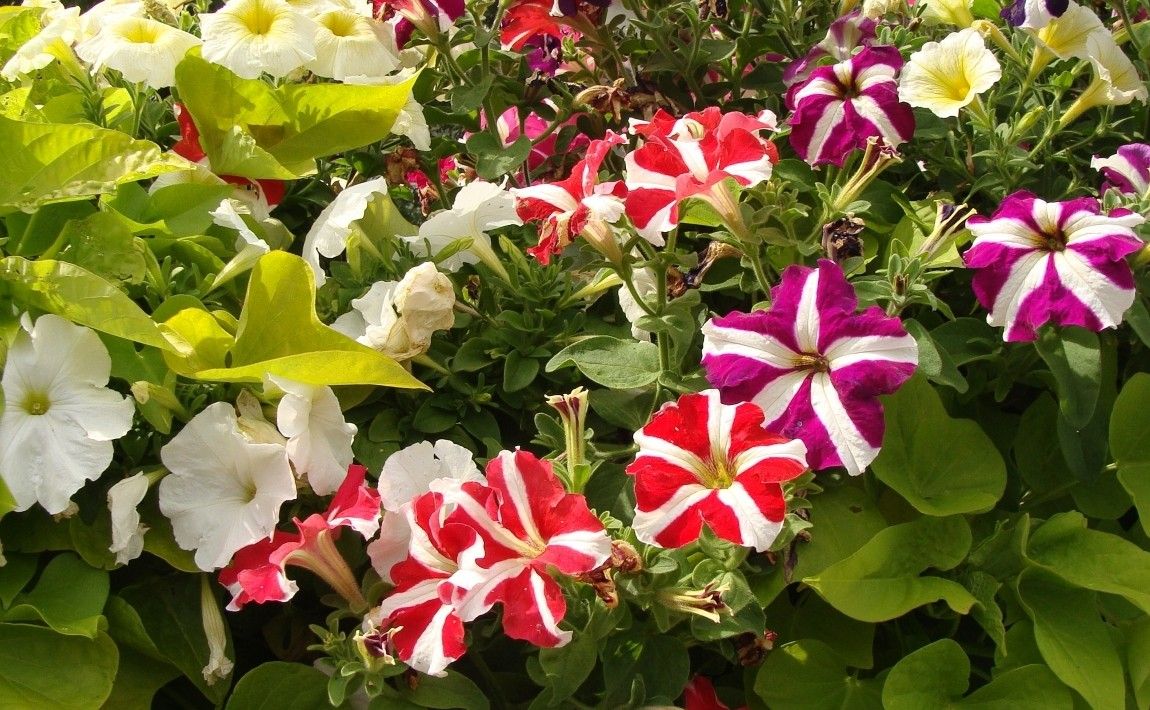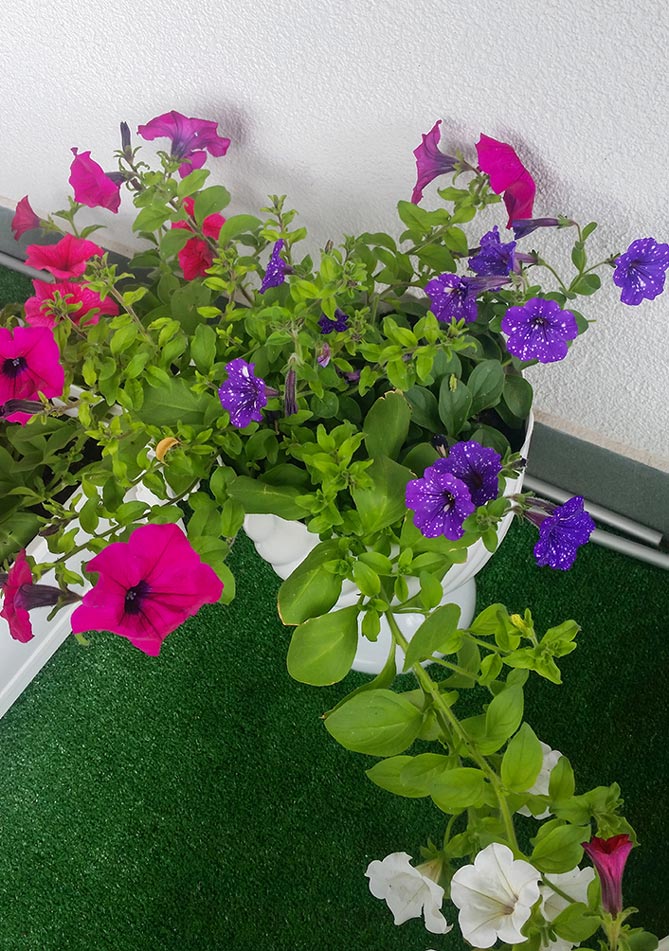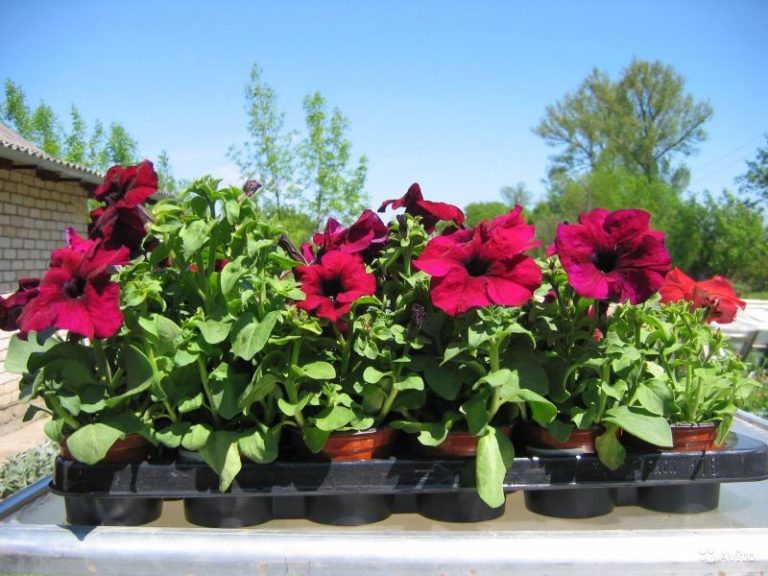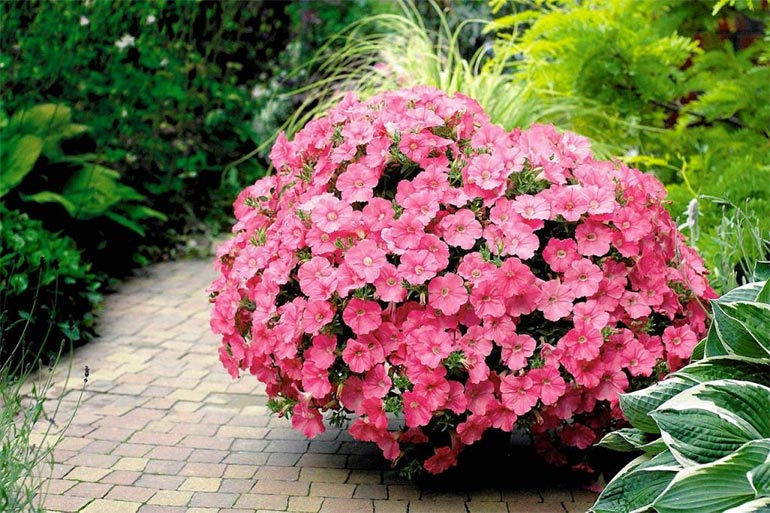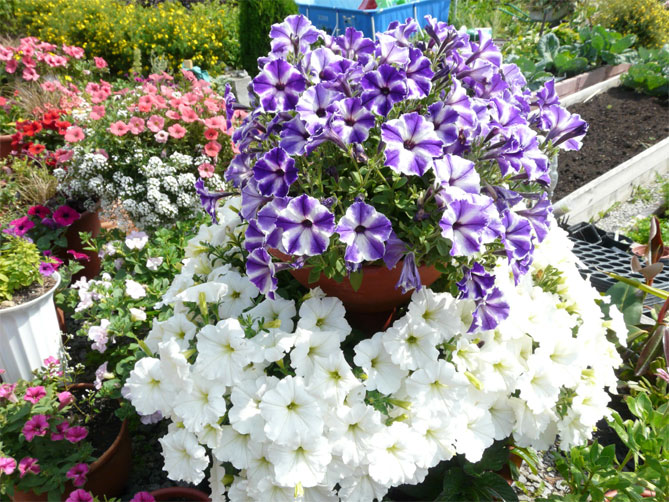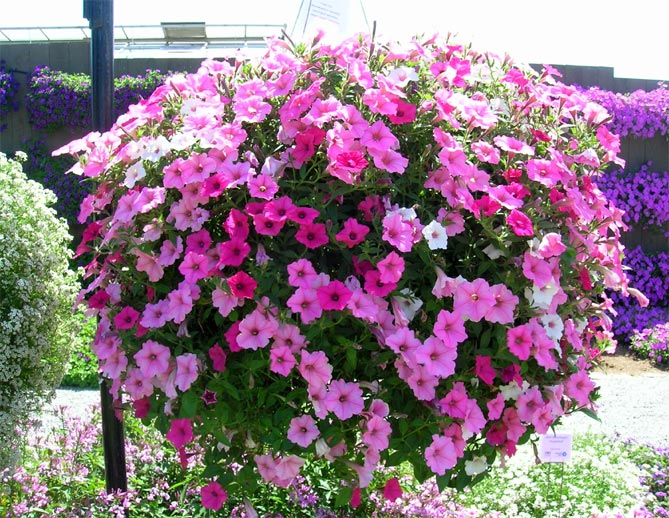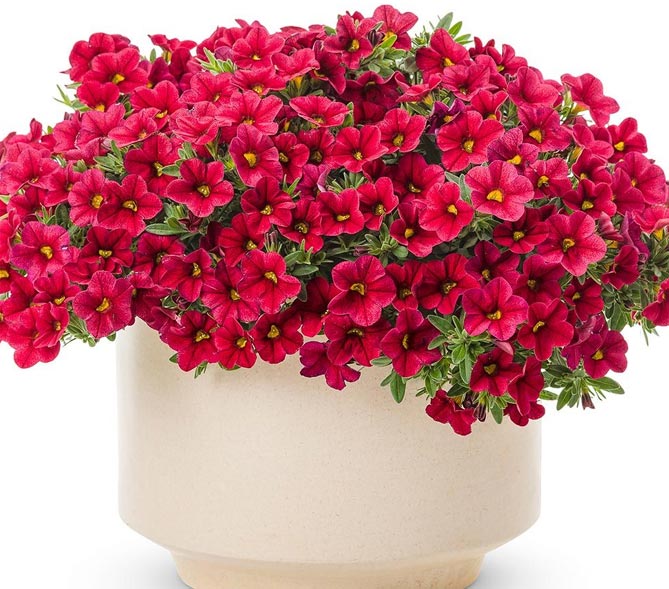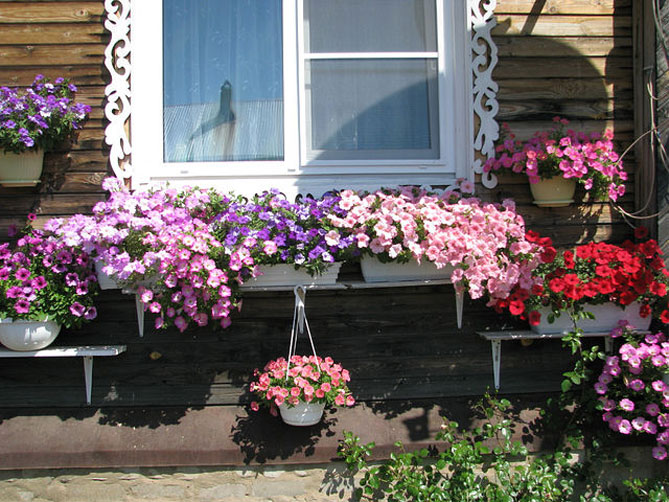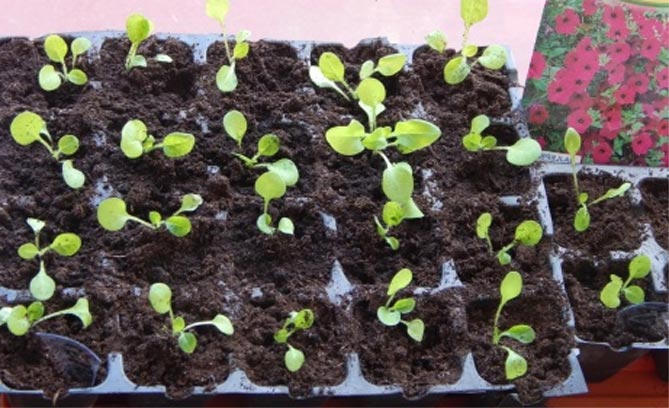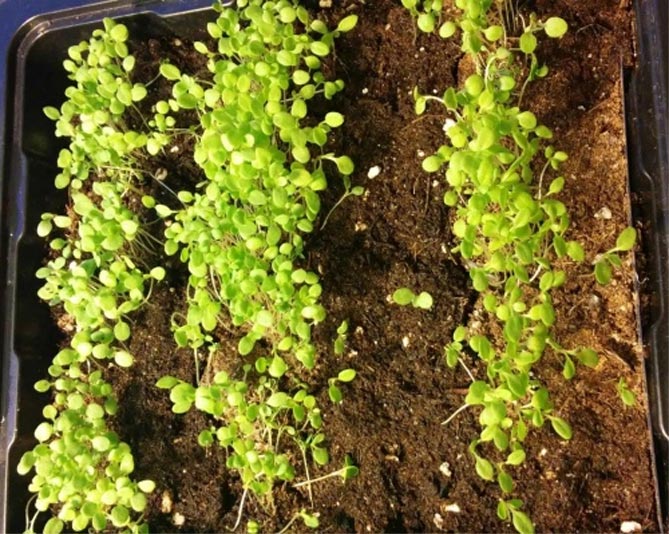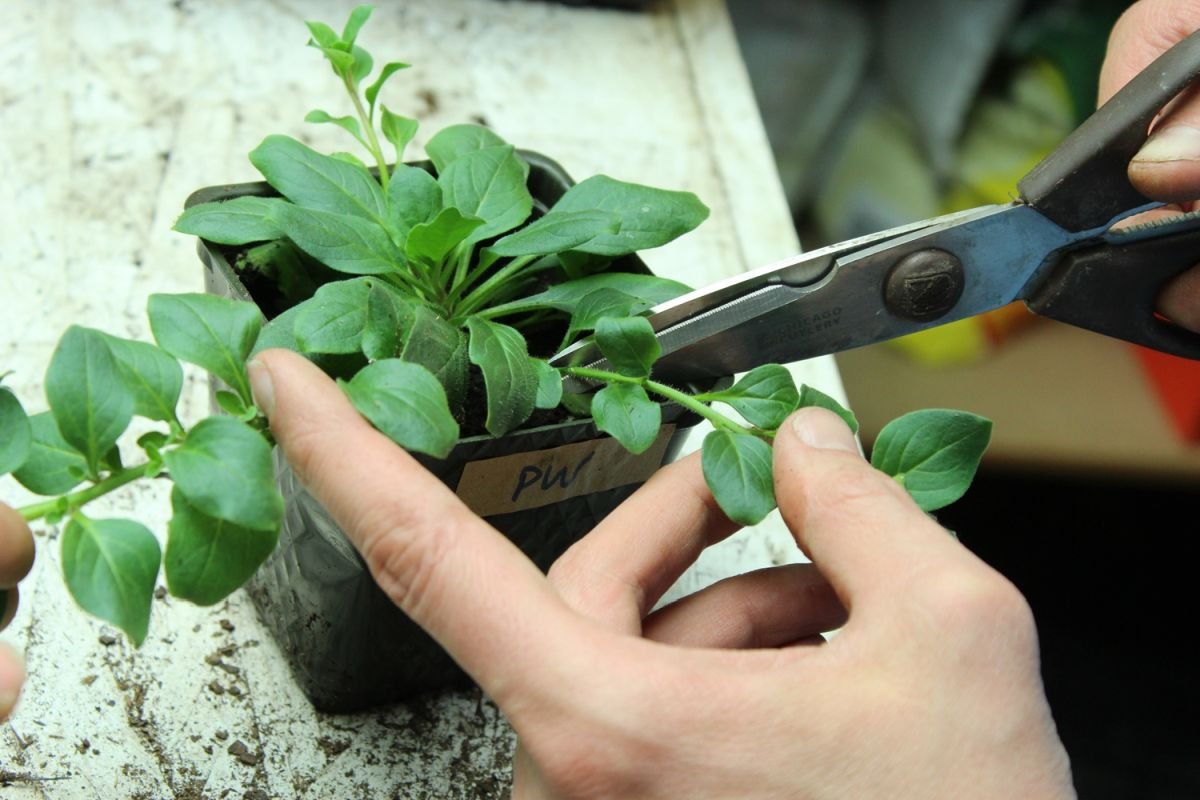Features of growing annual and perennial petunias
Growing petunia at home is difficult due to lack of light. In order for the plant to start blooming earlier, it is sown in February, additional lighting is required.
The soil for plants planted in pots, hanging baskets and other small containers should contain humus, peat, sand, mineral fertilizers. A layer of up to five centimeters of drainage is poured at the bottom of the containers;
At the end of March, seeds are sown in open ground, which should be nutritious and loose. In order for the seeds to germinate evenly, sift the soil from above;
Then they must be sprayed and covered with glass. The first shoots will sprout in a week. With the appearance of the leaves, the glass can be removed;
Terry petunias are propagated by cuttings, since only 40% of the plants survive when propagated by seed. Plants with small flowers begin to bloom a few months after planting, and with large flowers after 2.5 months;
When planting a multi-flowered petunia, you need to take into account the distance between plants, which should be 15 centimeters. For petunias with large flowers - 20 centimeters, for ampelous - 30 centimeters.
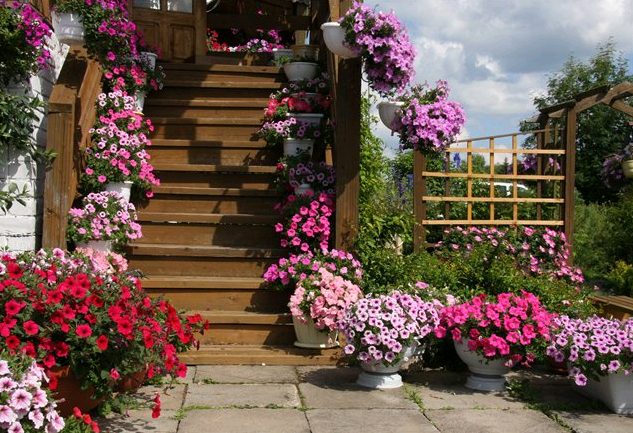
For this:
- In the fall, until the cold comes, we select bushes with good roots, transplant them into pots;
- Throughout the winter, plants are stored in this form in a cold place;
- In the spring we take the petunia into a warm room with good illumination, water it;
- When the plant wakes up, it will start growing again.
How to take care at home?
What you need for your pet's health:
- Remove fruit bolls in time. The plant should not waste energy on their maturation.
- If the petunia has long, lash-like stems, trim them back to half their length. And then begin to intensively feed and moisturize the bush.
- Cut off wilted flowers and shoots.
- Feed with mineral fertilizers.
- When the plant has come into effect, it should be fed with special additives containing potassium and phosphorus, as well as wood ash.
- To prevent chlorosis (disease), provide petunias with an iron supplement. For this, the Ferovit solution is sprayed onto the plant from a spray bottle. The procedure is repeated every three days until complete recovery. Also, the solution can be poured under the root.
What do you need to know to rejuvenate a flower?
Aging, petunia takes on a sloppy, unaesthetic appearance. Signs of aging:
- Dry long stems.
- Withered (tired) flowers and stems.
- Sluggish leaves turned yellow.
There is an easy way to rejuvenate her - pruning. Some growers prune petunias several times over the summer.
It depends on the:
- varieties;
- weather conditions;
- the state of the plant.
To rejuvenate petunia, you need to properly cut it:
- When pruning, do not cut all flowers.
- Only those shoots that have acquired a wilted and ugly look should be cut off.
- If the flowers have become small, then about 40-50% of the flowers should be cut off.
- Rejuvenation is usually done in July or August.
- After pruning, the plant begins to bush, giving new shoots and flowers.
TIP: After pruning, be sure to water the plant abundantly and feed it.
We plant a plant
Petunia can be planted both outdoors and in a pot or container. The best way is to sow seedlings. This is done in late March - early April. At the same time, flowering will begin around mid-June and will continue until the end of October.
Planting petunias with seedlings is good for indoor and balcony options. If you want to grow it outdoors, you can sow it directly into the soil around mid-May. Petunia can also be propagated by cuttings at the end of summer.
Seedling
For sowing seedlings, you will need turf soil mixed with leaf humus. You can also add peat and sand. Some growers plant seeds in peat tablets.
- Before sowing, the seeds should be mixed with sand and then sprinkled on the prepared substrate. You should not cover the seeds with a substrate from above.
- The container with the sown seeds must be covered with a transparent cap (glass or plastic) or foil.
Thus, a mini-greenhouse is obtained. You can use a ready-made mini greenhouse purchased from a store. After sowing, the seeds are sprinkled with warm water from a spray bottle.
Watch a video about sowing petunias for seedlings:
Technology and timing of planting petunias at home
They begin work with seeds by determining the date of planting for seedlings. There are certain tips:
- The apartment windows face south - you can start preparing seeds in early March.
- It is possible to create bright light for a long period - crops are created in February.
- Windows and a balcony are located on the north side - it is better to start working with seedlings in April.
Early planting will lead to plant weakness, numerous diseases. Flowering will begin later and will not be as abundant as during normal development.
The following stages of planting:
- Preparing seedling containers and permanent locations.
- Creation of soil: processing, checking for purity from pests, steaming, cooling.
- Sowing seed.
- Creation of a greenhouse effect.
- Location in a lighted place.
- Watering, loosening the top layer of the earth.
How to collect petunia seeds
Many people mistakenly think that small, barely noticeable seeds are somewhere in the dried leaves, and this is partly true.
This is how the opened seed box of petunia looks like:
Step-by-step instructions for collecting petunia seeds:
- Wait for the flower to wither and dry.
- Tear off the dry flower carefully.
- Next, you will see a green tubercle - the future seed capsule.
- When this seed pod ripens, dries up (turns brown) and begins to open, then you will see small dark brown or black seeds, which are much smaller than poppy (0.5 mm in diameter, 0.05 g weight). This usually takes up to 3 weeks. If the box does not open, although it has already dried up, then it can be torn off and already at home to open it yourself.
- Now you will need to cut off these heads (seed pods with sepals) and bring home.
- Already at home, carefully place the cut heads with boxes on a paper towel (or on a napkin), which then place in some not very deep dish.
- Now all that remains is to carefully pour out all the seeds from each box.
- And then collect in bags, sign and put in storage.
Popular varieties
Breeders have bred many varieties of petunias. The most popular are:
Milliflora
This is the name of a petunia with very small flowers. The diameter of the blossoming buds does not exceed 4 centimeters. The advantages of culture include long flowering, unpretentiousness to the conditions of detention. Bushes come with undersized and hanging shoots. Popular: Baby Gioconda Blue, Picobella Rose Star, Picobella Mix.
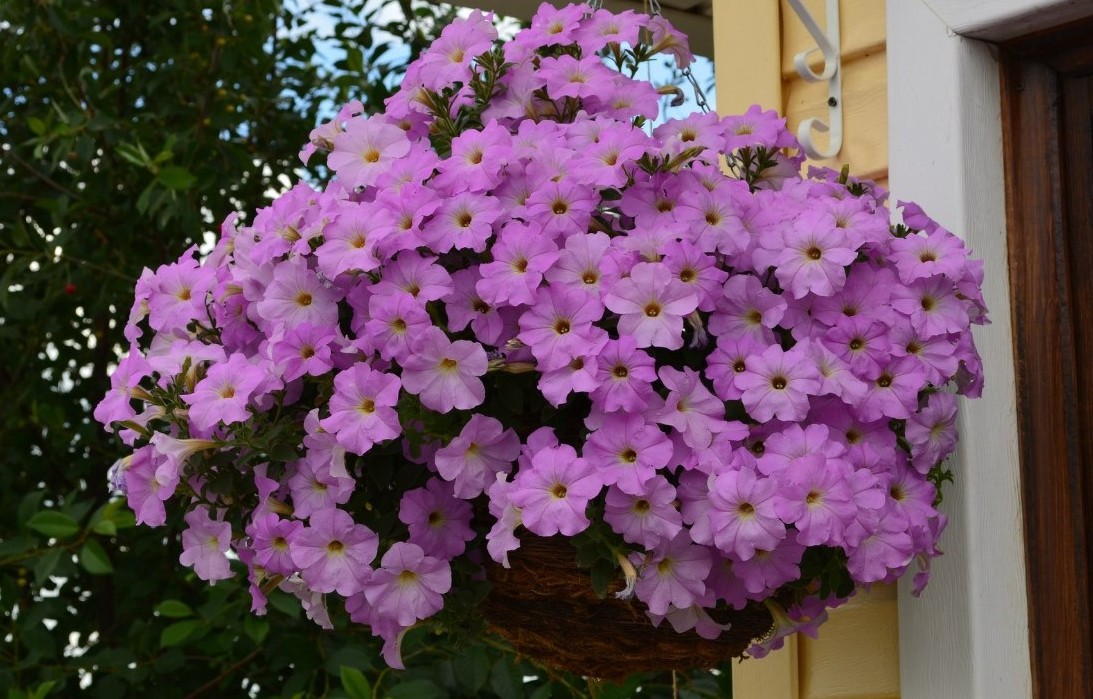
I like not like
Grandiflora
This is the second name for the large-flowered petunia. Buds up to 12 centimeters in diameter are simple or double. The petals are even or wavy. They place high demands on the content, so they are grown in a protected place. Popular varieties: Pink Ocean F1, Double Cascade Burgundy F1, Lemon and Blueberry F1.
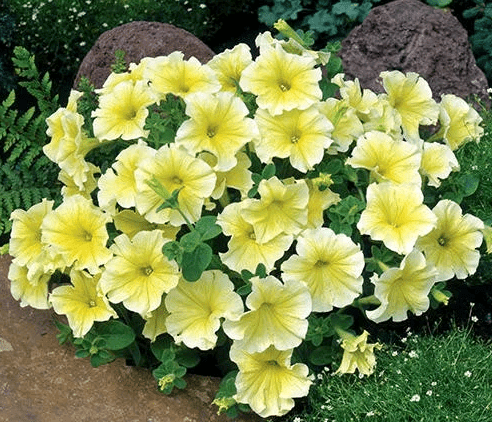
I like it, I do not like it
Sulfinium
This petunia variety has a high growth rate and branching of shoots. Bushes are large, resistant to adverse weather conditions. Shoots reach a length of 2 meters. Surfinia reproduces only in a vegetative way. Popular varieties: Yellow, Velvet Blue, Burgundy, Hot Pink, Tumbelina Suzanne.
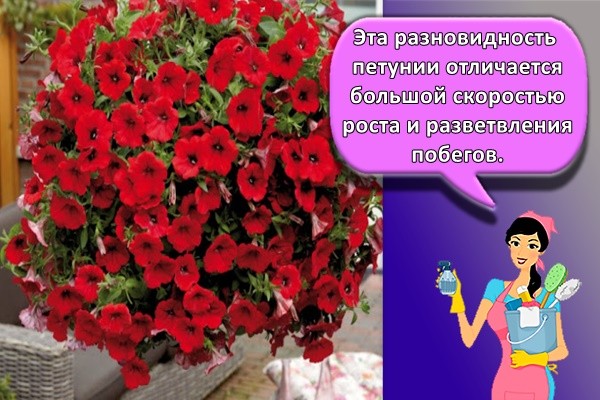
I like not like
Cherry
Creeping petunia Cherry F1 belongs to the Tidel Wave series of ampelous petunias. The height of the bush is 50-55 centimeters. The diameter of the bright red flowers is 5-6 centimeters. The variety is resistant to unfavorable climatic conditions. Bushes can be planted in open ground and in a container.
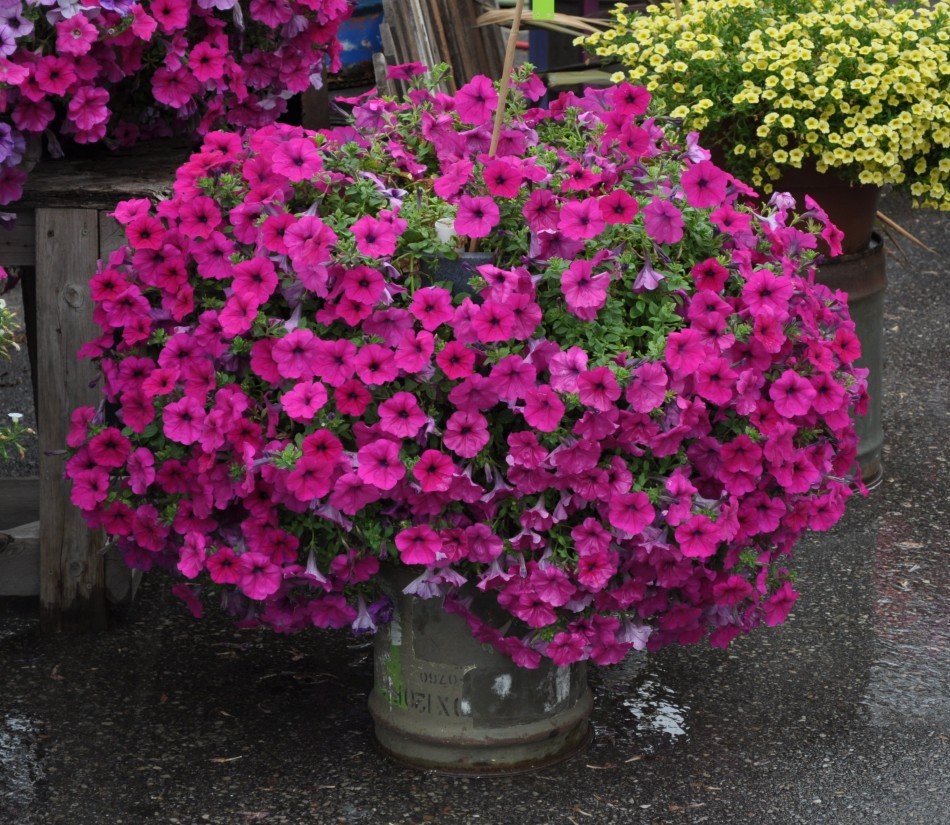
I like not like
Ramblin
Ampel petunia Ramblin F1 has a bright color of buds. The petals of the culture can be colored blue, pink, peach. The plant can be used to decorate flower beds, loggias, terraces. The most famous varieties: Sky Blue, Neon Rose, Burgundy Chrome, Salmon Capri.

I like not like
Typhoon
This is a representative of ampelous petunias. They are distinguished by strong shoots and long flowering. Popular is the variety Silver with white-pink buds, Red Vellyur with inflorescences, the petals of which are colored red.
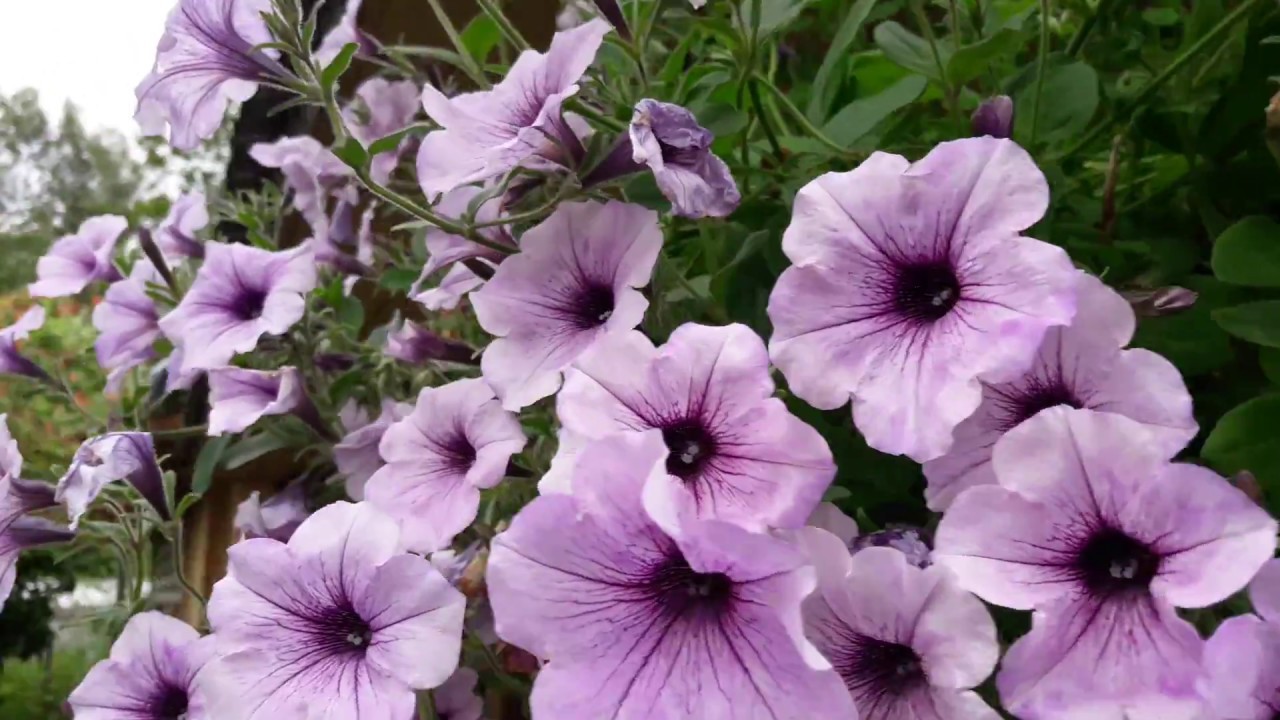
I like not like
Rose
Petunia Rose has a bright and long flowering. Its funnel-shaped numerous buds are colored pink. An unpretentious variety can multiply on the site by self-sowing. A delicate aroma emanates from the bushes during the flowering period.
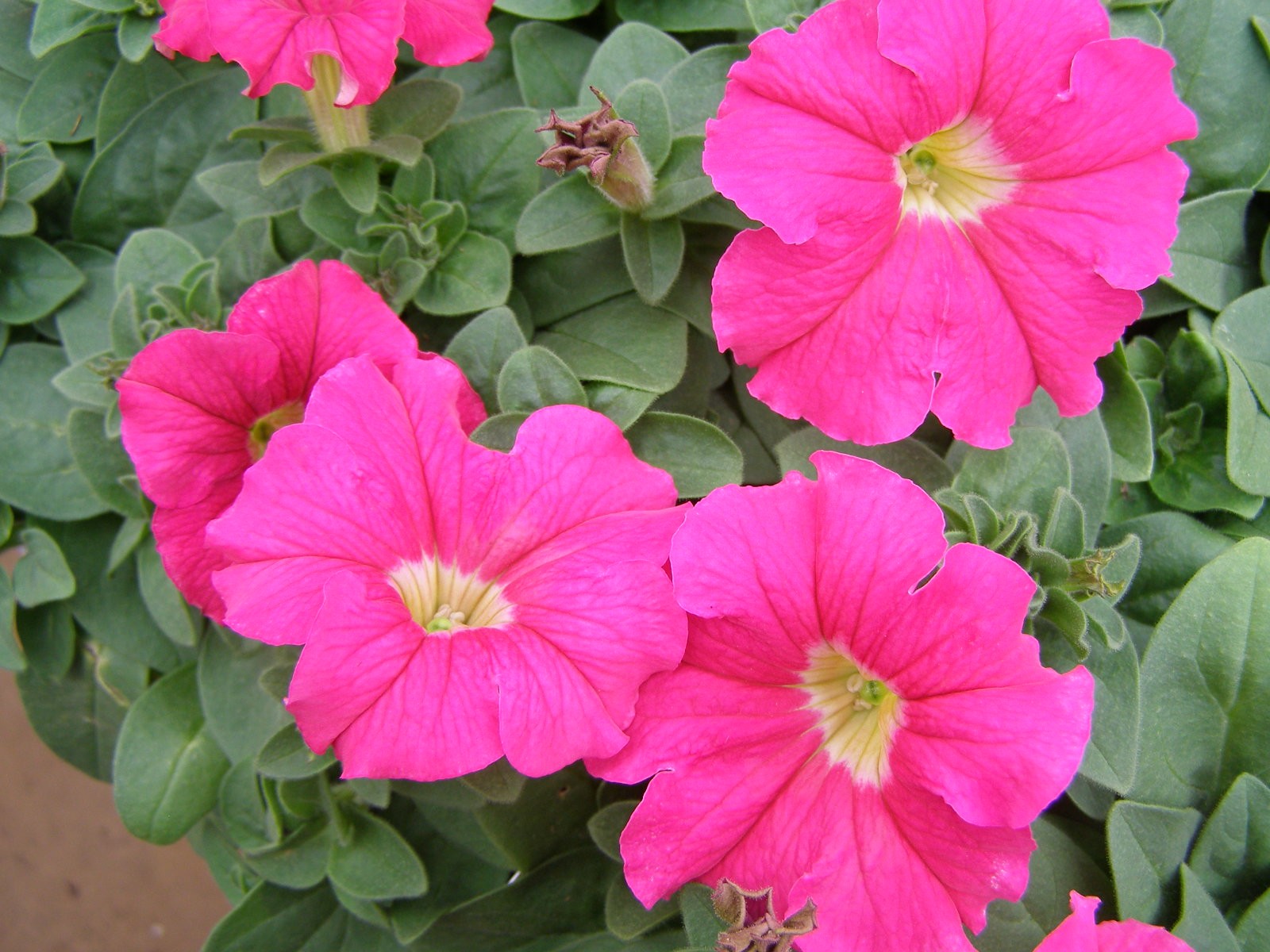
I like not like
Sowing petunia seeds for seedlings
Petunia seeds in the Moscow region and the middle lane are sown in late February - early March in seedling boxes. If you have the opportunity to provide good lighting, then sowing can be done earlier - in February, in the absence of this opportunity, it is better to postpone sowing until March, since the presence of sunlight, especially at first, favorably affects the development of sprouts into a healthy plant ...
Petunias sown in February without proper lighting lag behind in development and often March plantings catch up and overtake them in development.
The seeds of petunia are small, so they are not embedded in the soil, but sown over the surface, sprinkled with a thin layer of earth 1-2 mm and covered with a transparent lid. I use food storage containers with lids that work well for plants as greenhouses.
The optimum temperature for growing petunias is + 20..22 ° C. Make sure that the soil with the seeds does not dry out, but also is not very wet, periodically ventilate the greenhouse and shake off the condensation from the surface of the lid.
I prefer to plant granular seeds as the granules are larger. When sowing granular petunia seeds, tweezers can be used, which allows you to plant the seeds in even rows, which will ensure healthier plant development and simplify its further picking.
Soaking or not soaking petunia seeds in various kinds of stimulants is everyone's personal business. I don’t use it, it guarantees me that the plants will grow healthy on their own, and not by feeding them.
Petunia shoots appear in 5-7 days under favorable conditions. From this point on, it is worth gradually lowering the temperature, I resort to the method of more frequent and longer airing. First, once a day for 5-10 minutes, and I increase these intervals every week. After the seedlings get stronger and the first true leaves appear, I completely remove the cover from the "greenhouse" and make a pick.
 Seedling of petunia. Jennifer shimola
Seedling of petunia. Jennifer shimola
Sowing seeds
Many growers are wondering when to plant petunias when grown from seed. The start of sowing depends on the conditions of their germination and expected flowering. Seeds are usually sown at the end of January, but the process can continue until the end of May. The sooner the seeds are sown, the more efforts will have to be spent on growing seedlings, since too early dates suggest problems with ensuring the required temperature and mandatory additional lighting.
When sowing seeds late, this is done directly in open ground, but the plants will bloom later. The optimal time for sowing is the end of March. Then the flowering of the petunia will begin at the end of May or the first half of June.
On sale you can find seeds of two types: regular and granular, coated with a special composition.It contains nutrients and drugs to protect against disease. The shell dissolves when exposed to water.
The main methods of sowing seeds for growing petunias:
- A hydrogel is added to the soil mixture placed in prepared containers to maintain moisture and good seed development. For 1 part of the gel, take 4 parts of the earth. The product provides good germination and strong shoots. The seeds are poured onto a sheet of paper (there can be up to 10 thousand of them in 1 g) and with the tip of a toothpick dipped in water, the seeds are transferred into the soil. You don't need to deepen them. The container is covered with a lid and seedlings are expected to emerge.
- Sowing granulated seeds is done immediately in flower soil (you cannot take them with wet hands). Ordinary seeds should be lightly sprinkled with soil, then sprinkled with flower fertilizer and covered with glass.
For the normal development of sprouts when growing petunias from seeds at home in containers, additional illumination is required, for which a fluorescent lamp or a 15 W bulb is suitable. They are installed at a distance of 15 cm from the ground surface. The optimum temperature for seed germination is from +20 ° С to +22 ° С, then it can be reduced to +16 ° С.
During the first days, watering the seedlings is done with a pink solution of manganese to prevent blackleg infestation. The drug "Athlete" helps the sprouts to stretch less.
Planting petunias in open ground
When to plant petunia
Light-loving and thermophilic petunia should be grown in open sunny areas, protected from drafts and gusts of wind. The soil on the flower bed should not be clayey and acidic: humus and sand should be added to clay soil, and lime should be added to acidic soil. All this is done by digging a site to the depth of a shovel bayonet, while adding complex mineral fertilizer to the soil.
To grow petunias on terraces, balconies, verandas in containers and pots, use a soil mixture of leafy earth, peat, sand and humus in equal parts with the addition of a small amount of perlite.
Petunia is planted in open ground when the threat of recurrent night frosts has passed - in late May or early June. For disembarkation, it is better to choose a cloudy day or time after sunset.
How to plant petunia
Seedlings are first sprayed with Epin's solution and watered to make it easier to remove them from the pots. If you grew seedlings in a peat container, then you can plant them directly in it: the peat container will eventually be processed in the soil. Seedlings are removed from plastic cups together with an earthen clod and transferred into holes. When planting a multi-flowered petunia, the holes are placed at a distance of 15-20 cm from each other, there should be a distance of 20-25 cm between the seedlings of large-flowered varieties.Apel petunia bushes are planted with an interval of 30 to 40 cm.After filling the holes, the petunia is watered, and when the water is absorbed , the site is mulched with humus or peat.
When planting petunias in containers and boxes, the distance between seedlings should be one and a half times less than in open ground.
Varieties of small-flowered petunias bloom 70-75 days after sowing, large-flowered varieties - two weeks later.
Landing rules
You can sow petunias for seedlings in different ways. It is easier to sow pelleted seeds. For this, the substrate is placed in a container, compacted well, watered, and then compacted again.
Seed granules are spread on the soil surface at a distance of about 3-4 cm from each other. The spacing between the rows is approximately 5 cm. The sown seeds are then covered with a small layer of peat and slightly moistened using a spray bottle.
Regular seeds are sown in this way.
Sowing on the snow. A compacted layer of snow, approximately 0.5 cm thick, is placed in a container on top of the soil. Seeds are then sown on it. On white snow, dark petunia seeds are clearly visible and can be dispersed more or less evenly over the ground.A sharpened stick or toothpick can be used to distribute the seeds. When the snow melts, the substrate is moistened, while the seeds and snow penetrate the soil to the required depth. There is no need to add soil to the container.
-
Disembarkation using sand. Seeds are added to the sand, everything is thoroughly mixed. This mixture is evenly placed in containers with soil.
-
Landing on toilet roll paper. Plain paper is used, it is not recommended to use three-layer paper. Seeds on paper are also clearly visible and can be dispersed. In addition, the paper will not allow the seeds to sink to the depth. When wet, it will quickly dissolve and allow the roots to grow actively.

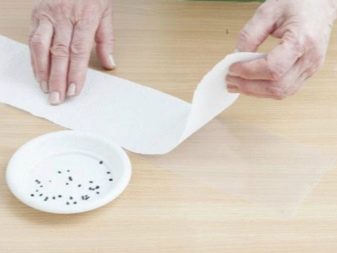
Another method of sowing petunias is done this way.
-
Take a piece of dense polyethylene of any length with a width corresponding to the width of the toilet paper roll.
-
It is covered with 2-3 layers of paper, which is then moistened with a spray bottle.
-
Step back from the top of the edge about 0.5 cm and place the seeds along the length of the tape at a distance of about 3 cm.
-
The paper tape is carefully wrapped, forming a roll, and loosely fastened so that it does not turn around. You can use an elastic band or thin string.
-
The resulting roll is placed in any container so that the edge with the petunia is on top.
-
The container is placed in a warm room and further maintains the moisture content of the paper. When the seedlings grow up and they need to dive, the roll is opened, and the seedlings are planted in containers with soil.
For planting, it is possible to use peat tablets. To do this, they are placed in containers and poured with boiling water. After the tablets have cooled and swollen, seeds are sown on them. This method is especially effective for planting pelleted seeds. 1-2 seed pills are placed on each tablet.
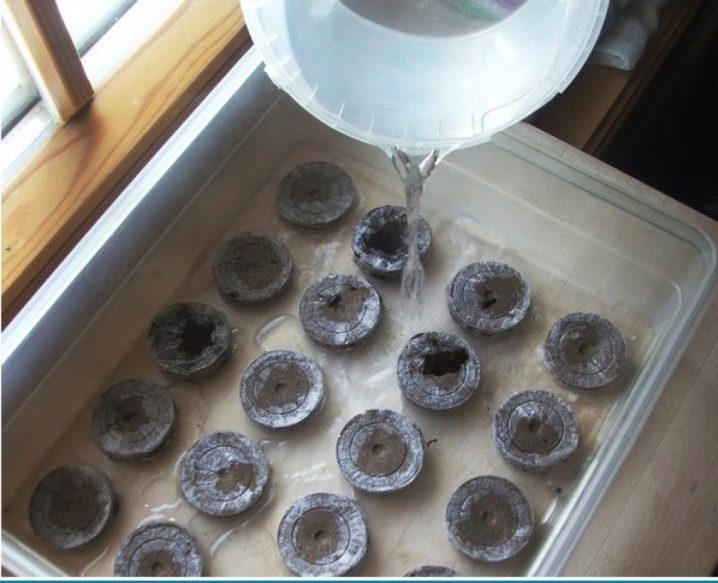
Planting petunias in boiling water is the newest method. Once the seeds are spread on the surface of the substrate, they are poured with boiling water from a syringe (or pear). You need to plant petunia in this way in plastic containers.
Containers with petunias planted in any of the described ways are covered with foil (or glass) and placed in a cool and darkened room for about 7 days, after which they are transferred to a warm place.
How to properly plant petunia seedlings in the ground or pots
Preparing seedlings for planting (hardening)
Before planting seedlings in open ground, transplanting them into a flowerpot and taking them outside (into the garden), you need to harden them (seedlings) in order to initially adapt the plants to more severe outdoor (external) conditions.
Alternatively, 5-7 days before disembarkation (transplant), you can gradually begin to take out seedlings in the daytime to a balcony (open loggia), to a greenhouse or to the street.
Planting seedlings in open ground
Step-by-step instructions for planting petunia seedlings in the ground on a flower bed:
- Spill the wells lightly with water.
- Carefully remove the seedlings from the pots (cups).
- Place in the previously made depressions, sprinkle with earth and squeeze slightly from the sides (so that the plant is fixed in the soil).
- If desired, it is beautiful to mulch.
- Spill abundantly with water.
Video: planting petunia seedlings in open ground in a permanent place
Planting in pots (balcony boxes)
First of all, you need to decide on the pots, namely, with their volume (size). If you have an ampelous variety, then one plant will require a nutritional area of about 10 liters. For more compact large-flowered and / or terry petunias - about 3 liters. In other words, 1 ampelous petunia or 3 large-flowered or terry petunias can be planted in a 10-liter flowerpot.
Further, everything is standard (similar to landing in open ground):
- Make holes in the pots to match the size of the earthen ball of seedlings (i.e. the pot).
- Gently remove the seedlings from the cups.
- Plant in the holes and squeeze slightly from the sides (while the root collar should be at the level of the soil, or you can deepen it a little).
- Drizzle lightly.
- Mulch (so that moisture does not evaporate quickly, especially if the pots will stand all day in the open sun). For example, sawdust can be used.
Video: planting seedlings of flowers (petunias) in pots
Growing petunias from seeds at home
To plant petunias at home, you will need flower potting soil, seedling containers, and glass to cover the planting. The glass can be easily replaced with a plastic corner.
Pour soil into a container, compact and water. The soil must be moist before planting petunia seeds for seedlings.
Spread the seeds of petunias on the surface, at a distance of 1 - 3 cm between them. Better not to sprinkle them with soil. They need light to germinate. The most any gardener can do is press the seeds lightly against the soil. This technique allows you to increase the contact of petunia seeds with the soil.
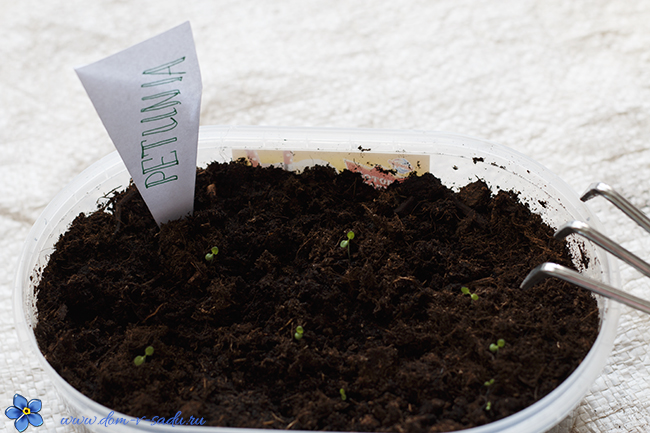
For germination, seeds need high temperature (about 25 degrees) and humidity (almost 100%). Such conditions are easy to create if you cover the seedling containers with non-woven cloth, glass or film and put them in a well-lit place. This covering will need to be removed when the seedlings grow a little. Therefore, we cover with glass and put a warm place.
Care consists in regularly spraying the plantings from a spray bottle with warm water. The soil must be constantly moist.
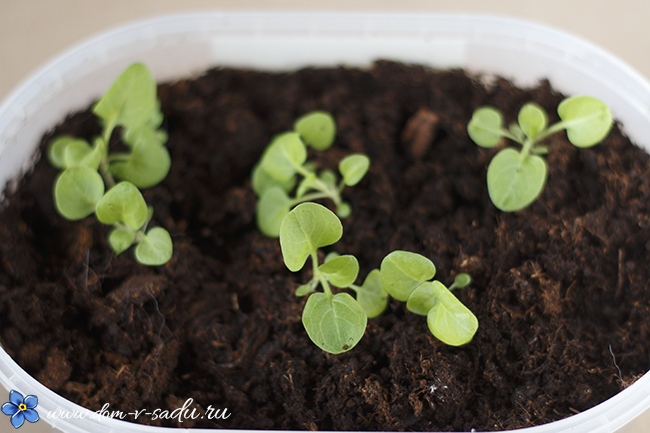
After the appearance of the first full-fledged leaves, you need to dive the petunia seedlings. In petunia agricultural technology, this process is considered the most responsible. The sprouts are still very weak and fragile. You need to be incredibly careful not to damage young shoots, especially their roots.

Growing petunia seedlings in peat discs helps to avoid these hassles. In addition, they have indisputable advantages: air and water permeability, as well as a rich nutritional composition. How to grow petunia from seeds in peat tablets is no big deal. It is enough to pierce each of them with a toothpick in the upper part. And put only one seed in the hole. It is only necessary to control the humidity in the container with peat tablets.
Useful advice on growing petunias for seedlings:
“I plant petunia in tablets, but in one tablet all the seeds from a pack of 11 pcs. This saves space (germination is still not 100%). Pre-soak and cut the shell from the upper surface. In the phase of 3 true leaves I dive. Since I plant a lot of different varietal petunias (up to 80 - 100 pcs.), This is a good savings in terms of money. "
During the first month of growth, the petunia seedlings may appear not to develop. This is due to the fact that at this moment the root system is actively developing. The green branches will start growing later, about a month and a half after the seeds germinate.
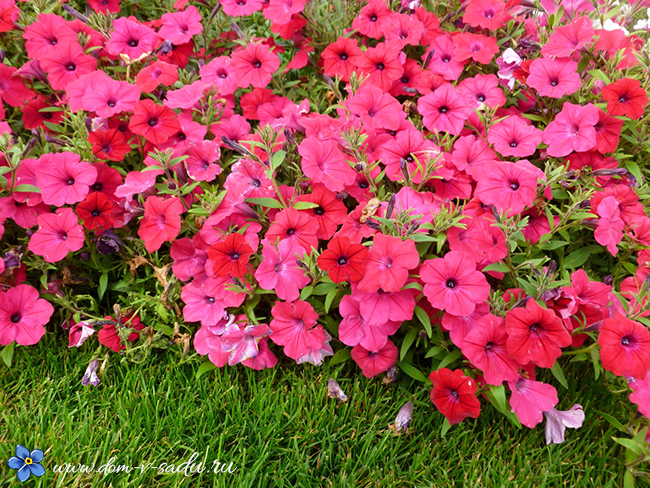
How to cultivate correctly?
The best petunia growing technology is:
- Large capacity.
- Regular feeding.
- Sufficient watering.
- Removal of faded flowers.
This plant loves loamy soil, but it takes root just as well in ordinary garden soil, and some varieties even in simple soil. But it is best to grow a beauty in a fertile one, which consists of peat, turf, river sand, leafy land. Another great option for growing is adding nitrophoska to the soil.
In the garden soil, the greenery of the plant becomes juicier and its growth accelerates, because they are very fond of a slightly acidic environment.
Growing petunias requires special light conditions. She prefers well-lit growing areas, however, blooms can fade in the scorching sun. Small blackouts are also needed.
Lighting is one of the main conditions for growing petunias. Therefore, well-lit areas with blackouts are ideal.
The soil in which the petunia grows should be moist, but not flooded. An excess of moisture will stop its growth.
It is also important to ventilate the soil in which the plant grows.Growing these flowers is not difficult if you just follow the lighting conditions, watering and soil composition.
Diseases of petunia
Proper planting and home care makes the plant resistant to the appearance of various diseases. However, there are times when the leaves of the flower turn yellow and dry. This speaks of a flower disease with such ailments:
- black leg - when the stem turns black and moisture gains. The cause of the disease is abundant watering;
- gray rot - covering the leaves with a gray bloom. The cause of the disease is cold air, or lack of lighting;
- brown spot - the presence of characteristic spots on the leaves. The cause of the disease is high humidity.
The harmful insects that infect plants include spider mites, aphids and slugs. Get rid of them with insecticides.
Bright, luxurious, regal, delicate, halftone, multicolored - all these compliments are addressed to the petunia. She is a real princess of the flower world. She can enchant, bewitch, forever make her subjects of numerous admirers of the flower kingdom.
Botanical description
Petunia (Petunia - lat.) Belongs to the genus of herbaceous perennial plants and shrubs of the Solanaceae family. In the wild, it grows in the rainforests of South America. The origin of the name comes from the word "Tabak" (Brazilian "Petun") due to their relationship.
There are about 25 species of petunias in the world, very different in appearance. Cultivation of flowers has been going on since the 18th century, the resulting hybrid varieties have been grown by flower growers as garden annuals for many years and are used to decorate balconies and flower beds. Ampel varieties look very elegant in suspended compositions, especially with a harmonious selection of colors. They are recommended to be used to decorate balconies when growing petunias at home, planting them in hanging pots or special boxes.
The plant grows in the form of a bush, the stems of which can be creeping, densely branched or erect, depending on the species. The height of the petunia can reach 15-70 cm. The plant has oval leaves 5-12 cm in size, arranged alternately on the stem. Its flowers can be simple or double (bred and fringed). The color of the flowers is varied: white, pink, blue, red, purple. There are varieties with veins, borders and stars.
Petunias bloom from July until the onset of cold weather. The fruits are in the form of boxes, inside of which there are many small seeds.

Additional tips and tricks
Growing petunias is a fun process. Florists who have been cultivating it for a long time give the following tips and recommendations:
- Petunia seeds quickly lose their germination. Therefore, it is better to purchase those that are in packaging with a layer of polyethylene or foil.
- Under no circumstances should the seeds be buried when sowing.
- Water the potted petunia every day. If the weather is too hot, moisten the earth twice a day: in the morning and in the evening.
- If a hydrogel is mixed into the soil, the moisture will last longer.
- You need to add nutrients 30-40 minutes after watering.
Petunia is a beautiful plant that blooms spectacularly from early summer to late autumn. If the florist will correctly carry out agrotechnical measures, the culture will delight him with its decorative appearance for a long time.
Share link:

